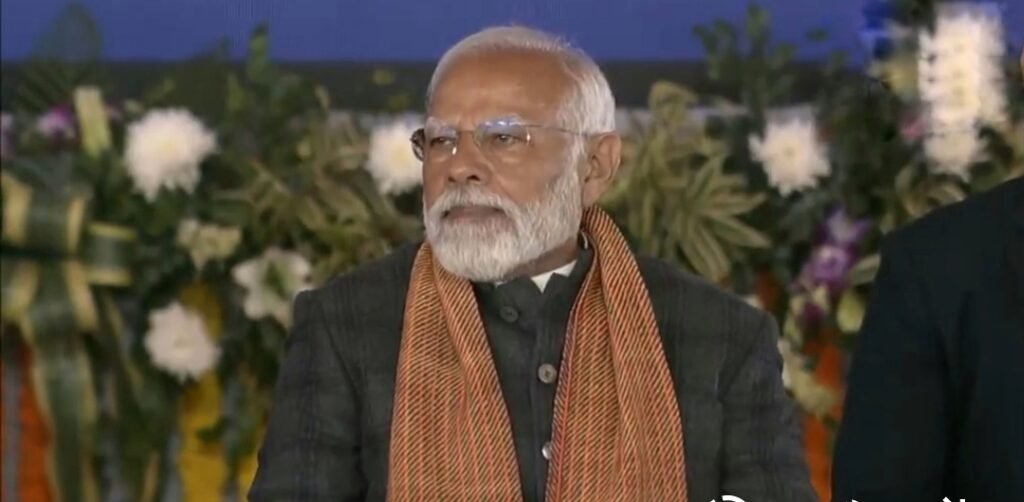
| Name | Narendra Damodardas Modi |
| Profession | Indian Politician |
| Age | 74 Years |
| Date of Birth | September 17, 1950 |
| Nickname | NaMo |
| sign/Sun | Virgo |
| Hometown / Place of Birth | Vadnagar, Mehsana (Gujarat) |
| Educational Qualifications | B.A. Political Science, University of Delhi |
| Political Party | Bharatiya Janata Party |
| Height in Feet / Inches | 5′ 7″ |
| Father | Damodardas Modi |
| Mother | Heeraben Modi |
| Net Worth | 3.07 Crore |
| Wife/ Spouse | Jashodaben Narendrabhai Modi |
| Children | 0 |
Narendra Damodardas Modi is an Indian Politician and the Prime Minister of India. He was born in Vadnagar, Mehsana district, Bombay State (p Gujarat) 1950 on 17th September. He is the son of Damodardas Mulchand Modi and Hiraben Modi. He was born in a Gujrat Family. He completed his higher education at Vadnagar. He was very keen on debating theatrical plays. He married Jashonda when she was 17 and he was 18. he left her and kept here hidden until 2021.
Modi’s Political Journey
Narendra Modi’s political journey is a testament to his transformation from a grassroots activist to one of India’s most influential and polarizing leaders. He hailed from a modest background. His early association with the Rashtriya Swayamsevak Sangh (RSS), a right-wing Hindu nationalist organization, laid the ideological foundation for his future political endeavors. In 1987, Modi joined the Bharatiya Janata Party (BJP). Quickly rose through its ranks due to his organizational skills and strategic acumen. By 2001, he was appointed as the Chief Minister of Gujarat, a position he held until 2014. His tenure was marked by significant economic development and industrial growth. It was also stained by the 2002 Gujarat riots, which drew national and international criticism.
Prime Minister of India
Modi’s national prominence surged when he was declared the BJP’s prime ministerial candidate for the 2014 general elections. Campaigning on promises of economic revival and good governance, he led the BJP to a historic victory, securing a majority in the Lok Sabha. As Prime Minister, Modi launched several flagship initiatives, including “Make in India,” “Digital India,” and “Swachh Bharat Abhiyan,”. Aiming to boost manufacturing, digitize services, and improve sanitation, respectively. In 2019, he secured a second term with an even larger mandate. His government undertook significant policy decisions, such as the abrogation of Article 370, which revoked the special status of Jammu and Kashmir. The enactment of the Citizenship Amendment Act (CAA) sparked widespread protests and debates over its implications. The 2024 general elections presented new challenges. While the BJP emerged as the single largest party, it fell short of an outright majority, securing 240 seats. Consequently, Modi formed a coalition government with the support of allies in the National Democratic Alliance (NDA), including the Telugu Desam Party (TDP) and Janata Dal (United) [JD(U)]. This marked a shift from his previous terms, necessitating greater collaboration and consensus-building within the coalition.
Modi’s third term as India’s Prime Minister
Modi’s third term has been characterized by both opportunities and challenges. On the international front, he continues to position India as a rising global power. Engaging in strategic partnerships and advocating for a multipolar world order. Domestically, his government faces pressing issues such as unemployment, inflation, and social polarization. Critics argue that his administration’s emphasis on Hindu nationalism has deepened societal divisions. While supporters credit him with enhancing India’s global stature and pursuing economic reforms. As Modi navigates his third term, his leadership style and policy decisions will significantly influence India’s trajectory. Balancing economic growth with social cohesion will be pivotal in shaping his legacy and the nation’s future.
He as a Hindutva
When Narendra Modi became the Prime Minister of India, the activities of the organization Hindu Nationalist expanded. It includes promoting the Hindu religion. It was a campaign against the conspiracy theory of “Love Jihad. It was an attempt to celebrate Nathuram Godse, the one who assassinated the Government officials, Mahatma Gandhi. The link between the BJP and the Rashtriya Swayamsevak Sangh (RSS) got strengthened under Modi. He provided electoral support to individuals placed in government roles. He appointed Yellapragada Sudershan Rao.
Modi then, in 2019, enacted a citizenship law that was in favor of non-Muslim minorities from the neighboring countries. Which leads towards global criticism and protest that were stopped by the pandemic of COVID-19 pandemic. This situation raised tension, escalating into the Delhi riots. Which results number of fatalities, mainly among Muslims. Then he made the practice of Triple Talaq illegal, which is a form of divorce in Islamic law. Then he ended Article 370 of the Constitution of India, which gives autonomy to Jammu and Kashmir. Which made it 2 territories rather than one, Ladakh and Jammu and Kashmir. This brought a lot of chaos, the lockdown of the internet, and a lot of political leaders were detained. The government did not take action against this situation, and this tells how the BJP was influencing the Government.
In the 2024 election campaign, he labeled Muslims as infiltrators and claimed that if his opponents won, the Muslims would seize India’s wealth. However, he later said he was not targeting one particular religion; the people who check facts and read between the lines could get multiple meanings from a single line.
Narendra Modi got number of Awards nationally and internationally. He wrote books Jyotipunj It was related to RSS, Exam warriors and many other short stories for the children. He has also penned down Gujrat garba songs. He appeared in reality shows and there are a lot of docudramas and shows are on him.


No Comments